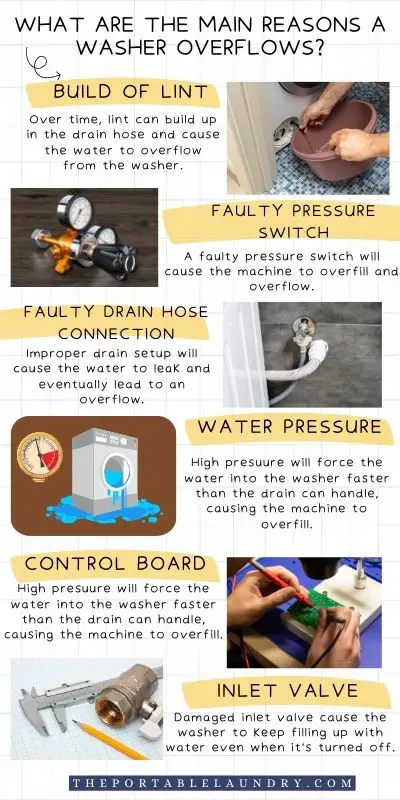A washing machine may overfill for a variety of reasons. Some of the common reasons include low water supply, lint buildup in the drain hose, a faulty pressure switch, a faulty control board, a faulty water inlet valve, or even a defective water level switch.
Key Takeaways
- There can be one or many reasons why a washer overfills. It can be anything from a low water supply line to a faulty component.
- It’s important to perform regular maintenance of your washer in order to avoid any leakage or overflow issues.
- In most cases, a choked water inlet valve or a clogged drain hose are the primary reasons that trigger overfilling.
- If the issue persists, it is advisable to call a technician or check the user manual for troubleshooting steps.
- Before troubleshooting check if the washer is still under warranty as you may void the warranty by doing self-troubleshooting.
What are the common symptoms and possible solutions to washing machine overfill problems?
There are a few common symptoms associated with an overfilled washing machine.
These signs may help you diagnose the issue and determine the best course of action.
Washing machine keeps filling and draining
It’s likely that the water inlet valve is either damaged, worn out, or choked if your washer keeps filling up while running a drain cycle.
In order to rule out or confirm the water inlet valve issues, simply unplug the washer and see if the washer continues to fill. If it does fill, the intake valve is damaged.
Another thing that you can check is the water pressure. If the water pressure is too high, it will force the water into the washer faster than the drain can handle, causing the machine to overfill.
If you determine that your washer is filling up due to high water pressure, you’ll need to adjust the water pressure regulator.
Lastly, make sure that the drain pipe is at least 30 inches high so that gravity can do its job and the water can drain properly.
Washing machine filling up with water when off
A damaged water inlet valve or a faulty water pressure switch are the two main reasons why a washing machine may continue to fill up with water even when it’s turned off.
You will need to replace the water inlet valve if it is damaged.
Washing machine overflows during spin cycle
Overloading your washer is the primary reason it overflows during a spin cycle.
So, if you’ve overloaded your machine, all you need to do is redistribute the load and restart the cycle.
Another possible cause of this issue is a faulty pressure switch.
The pressure switch is responsible for turning off the water supply when the washer has reached its capacity.
If the pressure switch is faulty, it will fail to turn off the water, causing the machine to overfill and overflow.
With that said, the water inlet valve can be another area where you can focus, as it is common for a washer to overfill and overflow if the water inlet valve is choked.
Lastly, make use of good quality and suitable detergent since excess suds can also cause a machine to overflow during the spin cycle.
Also Read: How long is the spin cycle on a washing machine?
Washing machine overflows when filling
If your washer overflows when filling, it’s likely due to an overload or unsuitable detergent.
With that said, you may have to rule out choking in the drainage system if the problem is persistent.
To rule out other issues, you can try running a small load and see if the washer overflows. If it doesn’t, it means the overflows are likely due to overload.
Likewise, you can try switching the detergent and see if the problem subsides.
If the problem continues even after running a small load, you may need to check for blockages in the drain hose and also check the hose connection.
In the worst case, you may need to replace the drain hose.
What are the main reasons a washer overflows?

Now that you know about the common symptoms, let’s take a quick look into the main reasons why a washer overflows.
Build of Lint
Over time, lint can build up in the drain hose and cause the water to overflow from the washer.
This is because the accumulated lint restricts or blocks the water flow and causes the water to move back up and overflow.
In order to prevent this from happening, you should clean the drain hose on a regular basis.
Faulty Pressure Switch
A faulty pressure switch will fail to turn off the water, causing the machine to overfill and overflow.
You’ll need to replace the pressure switch if it’s faulty.
Faulty drain hose connection
Another common reason that is often ignored is a faulty drain hose connection.
If the hose isn’t connected properly, it will cause the water to leak and eventually lead to an overflow.
So, make sure that the drain hose is properly connected before you run a cycle.
Defective Pressure Hose
A faulty pressure hose will often cause the washer to leak.
Even the slightest of holes or tears in the pressure hose can cause leakage and overfill/overflow issues.
Water Pressure
If the water pressure is too high, it will force the water into the washer faster than the drain can handle, causing the machine to overfill.
If you determine that your washer is filling up due to high water pressure, you’ll need to adjust the water pressure regulator.
Possible blockage in pressure chamber
The water pressure chamber is a key component in a washer that helps to decide when the wash cycle needs to be triggered once the water fills up.
When your washing machine starts to fill with water, the rising level of water in the drum pushes the air up the chamber and up the hose.
What this does is trigger the pressure switch, signaling the controller to begin the washing cycle.
Therefore, if the pressure chamber is blocked, air can’t rise through the hose to activate the switch, resulting in overflowing.
So, if the pressure chamber is blocked or damaged, you will need to inspect it and get rid of any debris or blockages.
And if it’s completely dead, you will need to replace it.
Control Board
The control board is the “brain” of the washing machine as it controls all the operations.
If the control board is faulty, it can cause a number of issues, one of which is an overflow or overfilling of the washing machine.
A faulty control board may not be able to communicate with the pressure switch, water valve, or water level switch, thereby resulting in overfilling.
With that said, there are a few things that you can do in order to troubleshoot the control board.
First, check all the connections and make sure they are secure.
Next, check for any burnt marks or signs of damage on the control board.
If you notice any damage, it’s best to replace the control board. However, if the problem persists, you will need to have it repaired by a professional.
You can test the control board with a multimeter to check for continuity if you don’t notice any burnt marks, as chances are, it may still be working.
Also Read: How to replace washing machine PCB board?
Damaged Water Inlet Valve
A damaged water inlet valve will cause the washer to keep filling up with water even when it’s turned off. You’ll need to replace the valve if it’s damaged.
Overloading
An overloaded washer will have a hard time not only spinning the clothes but also draining the water. This will cause the machine to overfill and overflow.
How do you deal with a washing machine that overflows with bubbles?
Excessive use of detergent or using poor quality detergent are two main reasons why the washing machine overflows with bubbles.
With that said, it can be a combination of both excessive detergents as well as a choked drainage system that may cause the overflow.
To get around this, you can start by checking the drain hose, the water inlet valve, and all the possible hoses for any build-up or accumulation of debris that could possibly cause the blockage.
If you do find any blockages, remove them by using suitable cleaners.
And if all the connectivity is good, i.e., if there are no blockages, you can switch to a detergent with a low sudsing formula.
A detergent with a low sudsing formula will create less lather. Therefore, there is less chance of your washing machine overflowing with bubbles.
Last but not least, make sure you don’t overfill your washing machine, as that will put additional pressure on the washer, causing it to overwork and overflow.
How do you fix a washing machine that keeps draining?
To fix the draining issues, you can start by checking the drain hose for any kinks or blockages.
If you do find any kinks or blockages, remove them and see if that fixes the problem.
If not, you can try using a plunger to unclog the drain completely.
If that doesn’t work either, you will need to call a professional as chances are, there is a more serious blockage further down the line.
Final Thoughts
There are many reasons why your washing machine may overfill and overflow.
It can be anything from a faulty control board to a damaged water inlet valve or even high water pressure.
Whatever the reason may be, it’s important to troubleshoot and fix the problem as soon as possible to avoid any further damage to your washing machine.
Lastly, if you have never troubleshot any washing machine-related issues before, it’s best to consult a knowledgeable technician, as doing things on your own at times may do more harm than good.
Frequently Asked Questions
How do I stop my washing machine overflowing?
You can avoid overflowing by using good-quality detergents and by running smaller loads. Also, make sure that you distribute the load evenly so that your washer does not have a hard time spinning the clothes. Lastly, make sure to perform regular maintenance and cleanup to avoid any clogging.
How do I know if my washing machine drain is clogged?
To diagnose a clogged drain, remove the hose from the back of the washer and see if the water is flowing freely. If not, you will need to clear the obstruction.
How do I clean my washing machine drain?
It is best to use a plunger to clean your washing machine drain. If that does not work, you can try using a wire hanger or a plumber’s snake.
What to do if your washer fills with bubbles?
If the washer fills with bubbles, make sure that you use good-quality detergents. Adding half a cup of white vinegar to the washer should also help to keep the bubbles in check to a certain extent. With that said, check for leakage in the detergent dispenser as it may leak prematurely and cause foaming.
You May Also Like
- Why does the washing machine sound like a helicopter?
- Why is the LG washer making a loud grinding noise?
- How to fix the 4c error in the Samsung washing machine?
- How to Reset a Washing Machine? (Step by Step)
- How to get the LG Washer To Only Spin?
- Why Front load washing machine is not filling with water?
- Why Does The LG Washer Leak From The Door? (Solved)
- Why Does the Washer Turn Off Automatically?
- How to Winterize a Washing Machine? (6 Easy Steps)
- How to fix no power and no light issue on Washing Machine?
- How to Replace Tub-To-Pump Hose In Washing Machine?
- How to Replace The Door Of Your Top Load Washer?
- How to replace agitator dogs in a washing machine?
- Why is the Whirlpool washer not agitating? (With Troubleshooting)

